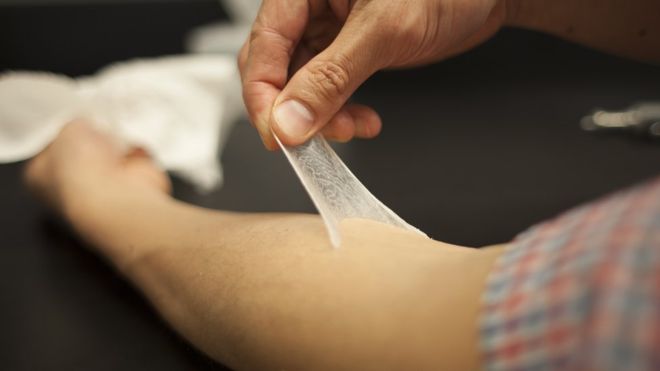Scientists make `second skin` to hide wrinkles

At the moment it is being explored as a commercial cosmetic product.
But the US scientists say their "second skin" might eventually be used to deliver medicines and sun protection.
Second skin
The team from Harvard Medical School and the Massachusetts Institute of Technology have tested their prototype product on a handful of volunteers, applying the formula to their under-eye bags, forearms and legs.
The polysiloxane polymer was made in the lab using molecules of silicone and oxygen as the building blocks.
Although it`s synthetic, it`s designed to mimic real skin and provide a breathable, protective layer.
According to the researchers, the temporary film locks in moisture and helps boost skin elasticity.
They performed several tests, including a recoil test where the skin was pinched and then released to see how long it takes to ping back into position.
As skin ages, it becomes less firm and less elastic and so performs less well in this sort of test.
Skin that had been coated with the polymer was more elastic than skin without the film. And, to the naked eye, it appeared smoother, firmer and less wrinkly.
The researchers, who have a spin-off company that could eventually market their patented formula, say the film is essentially invisible, can be worn all day without causing irritation and can withstand things like sweat and rain.
But more studies are needed before then. The polymer would also need safety approval from regulators.
Dr Tamara Griffiths of the British Association of Dermatologists says bags under the eyes are caused by the protrusion of fat pockets associated with ageing.
While entirely natural, some people see it as undesirable and seek ways to reverse it - sometimes resorting to surgery.
Dr Griffiths said: "The results [with the polymer film] appear to be comparable to surgery, without the associated risks. Further research is needed, but this is a novel and very promising approach to a common problem. I will follow its development with interest."
Prof Robert Langer, who led the work at MIT, said: "Developing a second skin that is invisible, comfortable and effective in holding in water and potentially other materials presents many different challenges.
"It has to have the right optical properties, otherwise it won`t look good, and it has to have the right mechanical properties, otherwise it won`t have the right strength and it won`t perform correctly.
"We are extremely excited about the opportunities that are presented as a result of this work and look forward to further developing these materials to better treat patients who suffer from a variety of skin conditions."















































